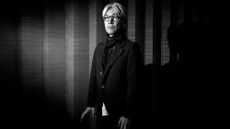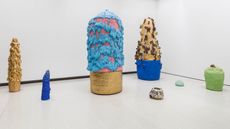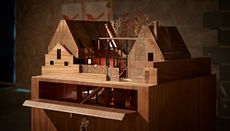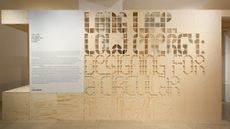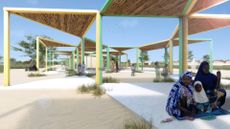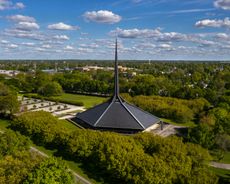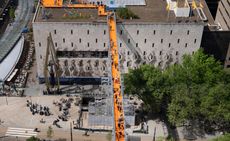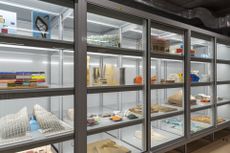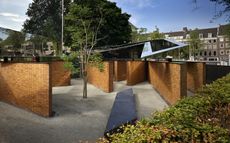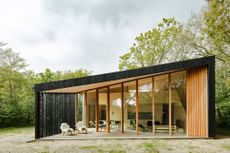An OMA/AMO show at Het Hem explores our balance with nature
We tour Het Hem's latest exhibition, ‘Chapter 5IVE’, a collaboration with OMA's Rem Koolhaas and Samir Bantal, director of AMO
- (opens in new tab)
- (opens in new tab)
- (opens in new tab)
- Sign up to our newsletter Newsletter
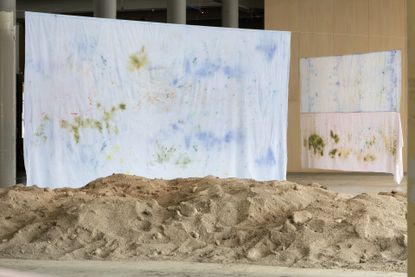
Het Hem’s latest exhibition ‘Chapter 5IVE’ is the result of long conversations between curator Rieke Vos, Dutch architect Rem Koolhaas and Samir Bantal, director of AMO, the think tank of the Office for Metropolitan Architecture (OMA). The installation of 15 groups of artworks is being shown at the cultural institution’s former munitions factory space in Zaandam, the Netherlands.
The framework of the exhibition was the extensive study of the relationship between city and countryside, which Koolhaas and Bantal began in 2012 and was first presented in the Guggenheim in 2020 under the title ‘Countryside, The Future’. ‘Globalisation’s initially glamorous image seems to be rapidly losing its shine in various parts of the world. Increasingly, mechanisms of the modern city seem to make life more uniform and upset our balance with nature, and people in the countryside are no longer willing to accept this,’ says Bantal. In other words, we must look to the countryside to help us achieve sustainable life on Earth. This is a key part of our battle against climate change and our fight for food security and an inclusive balance with nature.

Rem Koolhaas and Samir Bantal.
‘The artworks give space for a critical reflection on our relationship with rural life and nature, now and in the future,’ says Vos. The journey starts with a prologue: in German artist Christian Jankowski’s The Hunt (1992-1997), the artist walks into a supermarket with a bow and arrow like a primitive hunter gathering his life supplies – only to be faced by an unconcerned checkout assistant, who simply charges him for his ‘captures’. Humans tend to place themselves outside or even on top of nature. This comical anecdote questions whether there is an inherent conflict in the way we live and how we position ourselves in the ecosystem.
Our economy demands continuous growth, which outpaces nature’s clock. Hungarian-American artist Agnes Denes’ Tree Mountain – A Living Time Capsule – 11,000 Trees, 11,000 People, 400 Years (1982, 1992-96) is one of the earliest ecological artworks, in which thousands of silver firs were planted on a former gravel pit in Finland in a mathematical manner, using the Fibonacci sequence and golden ratio to encourage future civilisations to reflect on its cultural origins. ‘Rural areas are likely to be hardest hit by climate change, but they might also have the best solutions to deal with it,’ says Vos. Nature may work slowly, but on the other hand, Denes sends out the message that it is possible for humans to adapt to its rhythms if we have the will to do so.

Jasper Coppes. Installation view, ‘Chapter 5ive’, Het Hem
The exhibition moves towards a more futuristic sentiment. Vos describes Bantal and Koolhaas as ‘in a way techno philosophers’, whose open minds seek ways of using new technologies to change our behaviours while at the same time maintaining our values.
The Great Decline (2019) by Belgian artist Maarten Vanden Eynde is a copper memory chip, showing the floor plan of Norway’s Svalbard Global Seed Vault, which opened in 2008, covered with a large variety of seeds. ‘Seeds contain a lot of knowledge,’ says Vos. ‘They are one of the most complex rural technologies.’ The design is reminiscent of a lukasa, an ancient memory device created by the Luba kingdom (now part of the Democratic Republic of Congo) to document topographical and historical information about political events, people and places.

Musasa and Maarten Vanden Eynde. Installation view, ‘Chapter 5ive’, Het Hem
At the end of the exhibition hall is Emissary Forks at Perfection (2015-16), a live algorithmic simulation by American artist Ian Cheng. It portrays a far future, in which humans have become extinct, where a human is brought back to life by Al to see how they would react to the dystopian environment. ‘Perhaps the most intimate crisis we face today is the limit of human consciousness to really grasp non-human scaled complexity,’ says Cheng.
Vos adds, ‘Humans tend to think that we can control everything through technology. Cheng’s work paints another picture in which we are reminded that we will always be part of a holistic environment.’

Maarten Vanden Eynde. Installation view, ‘Chapter 5ive’, Het Hem

Bram Demunter. Installation view, ‘Chapter 5ive’, Het Hem

Ian Cheng. Installation view, ‘Chapter 5ive’, Het Hem

Rembrandt Van Rijn. Installation view, ‘Chapter 5ive’, Het Hem

De Onkruidenier. Installation view, ‘Chapter 5ive’, Het Hem

Agnes Denes. Installation view, ‘Chapter 5ive’, Het Hem
INFORMATION
hethem.nl (opens in new tab)
oma.com (opens in new tab)
-
 These artists are putting their stamp on the ‘Lady Dior’ handbag
These artists are putting their stamp on the ‘Lady Dior’ handbagNow in its seventh edition, ‘Dior Lady Art‘ invites international artists to reimagine Dior’s Lady Dior handbag – one of the house’s most memorable styles
By Jack Moss • Published
-
 Watch Ryuichi Sakamoto's mesmerising musical experience at the Brooklyn Museum
Watch Ryuichi Sakamoto's mesmerising musical experience at the Brooklyn MuseumAn iconic composer who traverses popular and high culture, Ryuichi Sakamoto pushes music into new frontiers, most recently in ‘Seeing Sound, Hearing Krug’, a new composition that pairs sound, flavour, light and texture
By David Graver • Published
-
 Last chance to see: ‘Strange Clay’ at The Hayward Gallery, London
Last chance to see: ‘Strange Clay’ at The Hayward Gallery, LondonAt London’s Hayward Gallery, group show ‘Strange Clay: Ceramics in Contemporary Art’ sees ceramic artists explore the physical, psychological, political and power of their medium
By Emily Steer • Published
-
 Celebrating supermodels: the oft-unsung heroes of architecture
Celebrating supermodels: the oft-unsung heroes of architecturePiercy & Company’s ‘Supermodels’ exhibition has just launched in London's Kings Cross, celebrating the art of miniature building
By Ellie Stathaki • Published
-
 ‘Long Life, Low Energy’ at RIBA celebrates sustainable architecture strategies
‘Long Life, Low Energy’ at RIBA celebrates sustainable architecture strategiesRIBA’s ‘Long Life, Low Energy’ exhibition opens, highlighting sustainable architecture strategies at their best
By Ellie Stathaki • Published
-
 Tosin Oshinowo on Sharjah, adaptable architecture and reuse
Tosin Oshinowo on Sharjah, adaptable architecture and reuseArchitect Tosin Oshinowo is curating the 2023 Sharjah Architecture Triennial around beauty, impermanence and adaptability; we catch up with her to find out more
By Shawn Adams • Last updated
-
 Exhibit Columbus 2022 kicks off in Indiana
Exhibit Columbus 2022 kicks off in IndianaThe newest cycle of the Exhibit Columbus architectural festival has began in Indiana, USA
By Audrey Henderson • Last updated
-
 View from the top: Rotterdam Rooftop Walk rises 30m above the city
View from the top: Rotterdam Rooftop Walk rises 30m above the cityThe temporary installation, a collaboration with architects MVRDV, offers visitors a new perspective of Rotterdam
By Hannah Silver • Last updated
-
 Het Nieuwe Instituut's Aric Chen on animals, archives and alternative shopping
Het Nieuwe Instituut's Aric Chen on animals, archives and alternative shoppingHet Nieuwe Instituut's new general and artistic director, and Wallpaper* contributor since 2008, Aric Chen talks to us about the cultural organisation’s exciting future and vision, for Rotterdam and beyond
By Ellie Stathaki • Last updated
-
 Studio Libeskind’s reflective geometries shape Holocaust memorial in Amsterdam
Studio Libeskind’s reflective geometries shape Holocaust memorial in AmsterdamStudio Libeskind crafts National Holocaust Memorial of Names in Amsterdam, designing dramatic geometric shapes that carry the message of remembrance
By Ellie Stathaki • Last updated
-
 Holiday Home is a sustainable Dutch island retreat
Holiday Home is a sustainable Dutch island retreatDesigned by Rotterdam-based studio Orange Architects, the timber-clad Holiday Home is a retreat that brings together flexibility, sustainability and a strong, sculptural aesthetic
By Ellie Stathaki • Last updated

